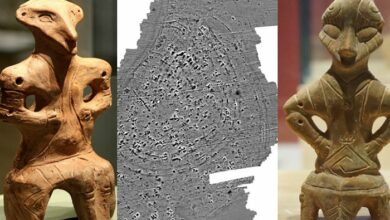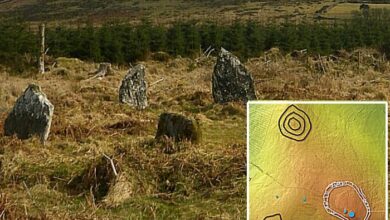Äskekärrskeppet (‘Äskekärr Ship’) – Only Viking Ship Found With Runes

Ellen Lloyd – AncientPages.com – The Äskekärrskeppet, also known as the “Äskekärr Ship,” is unique in many ways. It is currently displayed at the Gothenburg Museum in Sweden and stands out as the only Viking ship discovered with runes inscribed on it.
The ship was discovered in 1933 by John Antonsson, a farmer who stumbled upon it while draining a wet meadow on his property in Äskekärr village, now part of Ale Municipality, located along the River Göta in Sweden.
Äskekärrskeppet on display at the Gothenburg Museum. Credit: Public Domain
Initially unaware of his discovery’s significance, Antonsson reported what seemed to be remnants of a ship to the Museum of Gothenburg. Upon hearing about this intriguing find, experts initiated an archaeological excavation mission. Under Philibert Humbla’s supervision, what would later be recognized as Sweden’s first Viking ship discovery was meticulously excavated and preserved for future generations to study and admire. The Äskekärrskeppet holds a special place in history, archaeology, and mythology. This extraordinary ship has given us a unique perspective into the Viking era, corroborating many accounts from Icelandic Sagas as factual events.
The excavation of the Äskekärrskeppet. Image from the book Starrkärr-Kilanda socknar, 1975, Mona Lorentzson
The Göta river, where this ship was found, was much wider in prehistoric times than today. Since the Iron Age, it has played a crucial role as an essential conduit for trade and transportation. The Icelandic Sagas reference it as the launch point for Viking expeditions, and historically, it marked the boundary with Norway.
Once archaeologists started to excavate, they could see the ship was a Viking. During the Viking era, there were different classes of ships. The longships were mainly used as warships, and the ships called Knarrs (or Knorrs in Old Norse) served as slower passenger and cargo ships.
The Äskekärr Viking ship, when initially discovered, was dated through pollen analysis by geologist Harald Thomasson to either the late 7th century or early 8th century. Four clay pillars were left intact within the ship during excavation to ensure an accurate pollen analysis. Three decades later, a C14 analysis suggested a date of 830 A.D. for the ship. However, this sample was recalibrated in the late 1980s to around 900 A.D.. Concurrently, dendrochronology – a reliable method for dating wooden objects – estimated the construction date of the ship to be between 900 A.D. and 920 A.D.
Like the Norwegian Viking Gokstad Ship, the Äskekärrskeppet had a weakly arched keel that measured up to nearly thirteen meters during the excavation.
F Rune or Fehu. Credit: Adobe Stock – Serhii
During the preservation and subsequent assembly of the ship, inscriptions featuring runes and signs similar to runes were discovered. These runes belong to the Viking Age alphabet, commonly called the Futhark. Notably, the “F” rune or “fehu,” as it’s known in this context, has been identified on the ship’s planks.
The F rune or “Fehu” stands for cattle or livestock, symbolizing wealth.
Vidfamne is a reconstruction of the Äskekärrskeppet. Credit: Peter Lindström/CC BY SA 3.0.
Runes played an essential part in the lives of the Vikings. Thousands of inscriptions in stone, wood, and metal have been unearthed, and each item gives us a glimpse into a culture that believed in the power and protection of the gods, telling fortunes and casting spells, and the glory of war.
However, the Äskekärrskeppet is the world’s only Viking ship with runic carvings.
The Äskekärrskeppet, the only Viking Age ship excavated in Sweden, is displayed at the Gothenburg City Museum. The unique aspect of this exhibit is that it presents the ship exactly as it was discovered, without any efforts made towards its assembly or reconstruction.
Written by Ellen Lloyd – AncientPages.com
Copyright © AncientPages.com All rights reserved. This material may not be published, broadcast, rewritten or redistributed in whole or part without the express written permission of AncientPages.com
Expand for references








